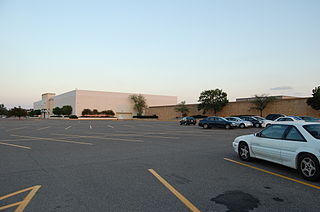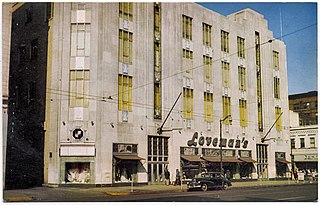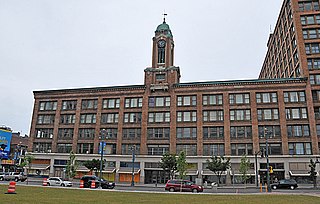
A department store is a retail establishment offering a wide range of consumer goods in different areas of the store, each area ("department") specializing in a product category. In modern major cities, the department store made a dramatic appearance in the middle of the 19th century, and permanently reshaped shopping habits, and the definition of service and luxury. Similar developments were under way in London, in Paris and in New York City (Stewart's).

Gimbel Brothers was an American department store corporation that operated for over a century, from 1842 until 1987. Gimbel patriarch Adam Gimbel opened his first store in Vincennes, Indiana, in 1842. In 1887, the company moved its operations to the Gimbel Brothers Department Store in Milwaukee, Wisconsin. It became a chain when it opened a second, larger store in Philadelphia, Pennsylvania, in 1894, moving its headquarters there. At the urging of future company president Bernard Gimbel, grandson of the founder, the company expanded to New York City in 1910.

Proffitt's was a department store chain based in Alcoa, Tennessee. The chain was founded in 1919 by David W. Proffitt and James Ellis. In 2006, the Proffitt's and McRae's stores were converted into Belk after Belk had acquired the two chains in July 2005 from Saks, Inc. At the time of their demise they operated 47 Proffitts & McRae's stores.

Joslins was a chain of department stores that was based in Denver, Colorado, United States.
L. S. Ayres and Company was a department store based in Indianapolis, Indiana, and founded in 1872 by Lyman S. Ayres. Over the years its Indianapolis flagship store, which opened in 1905 and was later enlarged, became known for its women's fashions, the Tea Room, holiday events and displays, and the basement budget store. As urban populations shifted to the suburbs, Ayres established branch stores in new shopping centers in several Indiana cities. Ayres also acquired retail subsidiaries in Springfield, Illinois; Fort Wayne, Indiana; and Louisville, Kentucky. Ayr-Way, the Ayres discount store subsidiary, became the first discount store launched by a full-line department store. By the end of the 1960s Ayres had become a diversified merchandising business with retail department stores, a chain of discount stores, specialty clothing stores, a home furnishings showroom, and a real estate holding company. A long-time Ayres slogan, "That Ayres Look", promoted the company as a fashion leader, and by 1972 it had become the oldest continuous retail slogan in the United States.

West Acres Shopping Center is a regional shopping mall located in Fargo, North Dakota near the intersection of Interstate 29 and 94. It is the largest mall in North Dakota. The anchor stores are JCPenney, Macy's, Forever 21, and Best Buy. Von Maur announced plans to open a location in a spot that was once occupied by Herberger's, filling all anchor spots.
The Stewart Dry Goods Company—alternately known as Stewart Dry Goods, or Stewart's—was a regional department store chain based in Louisville, Kentucky. At its height, the chain consisted of seven store locations in Kentucky and Indiana. The chain in its later years operated as a division of New York–based Associated Dry Goods.
The Powers Department Store of Minneapolis, Minnesota was a department store chain with roots dating to 1873, and that, at its peak, consisted of 7 locations in Minnesota.

The May Company Ohio was a chain of department stores that was based in Cleveland, Ohio, United States.

Sibley, Lindsay & Curr Company, known informally as Sibley's, was a Rochester, New York–based department store chain with stores located exclusively in the state of New York. Its flagship store, at 228 East Main Street in downtown Rochester, also housed its headquarters and featured an elegant executive dining room on the top floor.

Northtown Mall is a shopping mall located in Blaine, Minnesota, United States. The mall's anchor stores are Hobby Lobby, Best Buy Outlet, 2 Becker Furniture World stores, and Burlington. In addition, Northtown Mall features over 100 stores and restaurants, as well as a food court and Paladin Career and Technical High School public charter school which was open in September 2002. The mall is owned by 4th Dimension Properties. Over 5.5 million people visit the mall every year.

Hahne & Company, commonly known as Hahne's, was a department store chain based in Newark, New Jersey. The chain had stores located throughout the central and northern areas of New Jersey.

Loveman's of Alabama was a Birmingham, Alabama-based chain of department stores with locations across Alabama. It adopted this name to distinguish it from Loveman's department stores operating in Chattanooga, Tennessee, and in Nashville, Tennessee.

The Lower Woodward Avenue Historic District, also known as Merchant's Row, is a mixed-use retail, commercial, and residential district in downtown Detroit, Michigan, located between Campus Martius Park and Grand Circus Park Historic District at 1201 through 1449 Woodward Avenue and 1400 through 1456 Woodward Avenue. The district was listed on the National Register of Historic Places in 1999.

Downtown Fargo District, or Downtown Fargo Historic District, is a historic district in Fargo, North Dakota that was listed on the National Register of Historic Places in 1983.

The Zollinger-Harned Company Building, now known as The Sovereign Building, is a historic department store building on Hamilton Street in the Center City section of Allentown, Pennsylvania.

The Urbana-Lincoln Hotel – Lincoln Square Mall is a historic building complex located at 300 South Broadway Avenue in Urbana, Illinois. The Tudor Revival style hotel was built in 1923. In 1964, the mall was built as an extension of the hotel; it was one of the first fully enclosed shopping malls in Illinois. The hotel, the mall, and the building complex was listed on the National Register of Historic Places in 2006. As of October 2017, the mall was still in operation, however the hotel was closed.

Sibley's, Lindsay and Curr Building is a historic commercial building located at Rochester in Monroe County, New York. It was designed by noted Rochester architect J. Foster Warner and built for Sibley's in 1904. The original wing of the building was constructed in 1906 as a five-story, Chicago school style skeletal steel building sheathed in brown Roman brick with deeply set Chicago style windows, topped by a clock tower with Baroque and Renaissance style details. Additions were made to the building in 1911 and 1924, including a 12-story tower section.

T.S. Martin and Company, also known as Karlton's, Fishgalls & Cameo, is a historic building located in Sioux City, Iowa, United States. It is an L-shaped structure that fronts both Fourth Street and Nebraska Street. It was occupied by one of three locally owned department stores from 1894 to 1919. The buildings on Fourth Street were originally built in 1885. T.S. Martin and Company itself dates from 1880 when Thomas Sanford Martin opened a dry goods store in rented commercial space. He first acquired 515-517 Fourth Street in 1885, which he leased to a clothing store, and his brother Louis opened T.S. Martin and Company Shoes by leasing 519 Fourth Street the same year.

Rankin's was a department store at 117 West Fourth Street at Sycamore in downtown Santa Ana, California. The Rankin Building is listed on the National Register of Historic Places on its own and also as a contributing property of the Downtown Santa Ana Historic Districts.




















